Roter Kulturkampf der KP China: Das feudale Dalai- Lama- Tibet ist tot, es lebe ESG- Xizang für Gen Z und den Global South, Kampf gegen Disney und um die nationalen Religionen
Na, da könnte sich das Goethe-Institut ja mal eine Scheibe von der Kulturarbeit der KP China abschneiden. Digitale Botschhafter um nicht zu sagen, digitale Kulturerbebotschafter . Die Terracotta-Armee und andere historische Figuren als Chinas virale Botschafter. Xi Jinpings Global Civilizational Inititative digitalisiert und sehr innovativ. Ob es einen digitalen Goethe oder Marx oder sonstige historische Kulturfigur dann auch mal seitens der USA oder Deutschlands geben wird? Laut Artikel der Global Times ist die Zielgruppe auch die Jugend, die mittels moderner Digitaltechnologie an das kulturelle Erbe der Nation oder früherer Dynastien und der Geschichte seiner Reiche im Rahmen der nationalen Wiedergeburt und des chinesischen Traums nun auch vorerst an die virtuelle Realität herangeführt wird, um das Reich der Mitte und die imperiale Weltmacht China als ihre Zukunftsaufgabe in Zukunft bis 2049 spätestens auch real und analog werden zu lassen.
“NW China’s Shaanxi Province introduces digital ambassadors
Four figures diversify presence of rich history
By Lu Wenao Published: May 24, 2023 10:28 PM
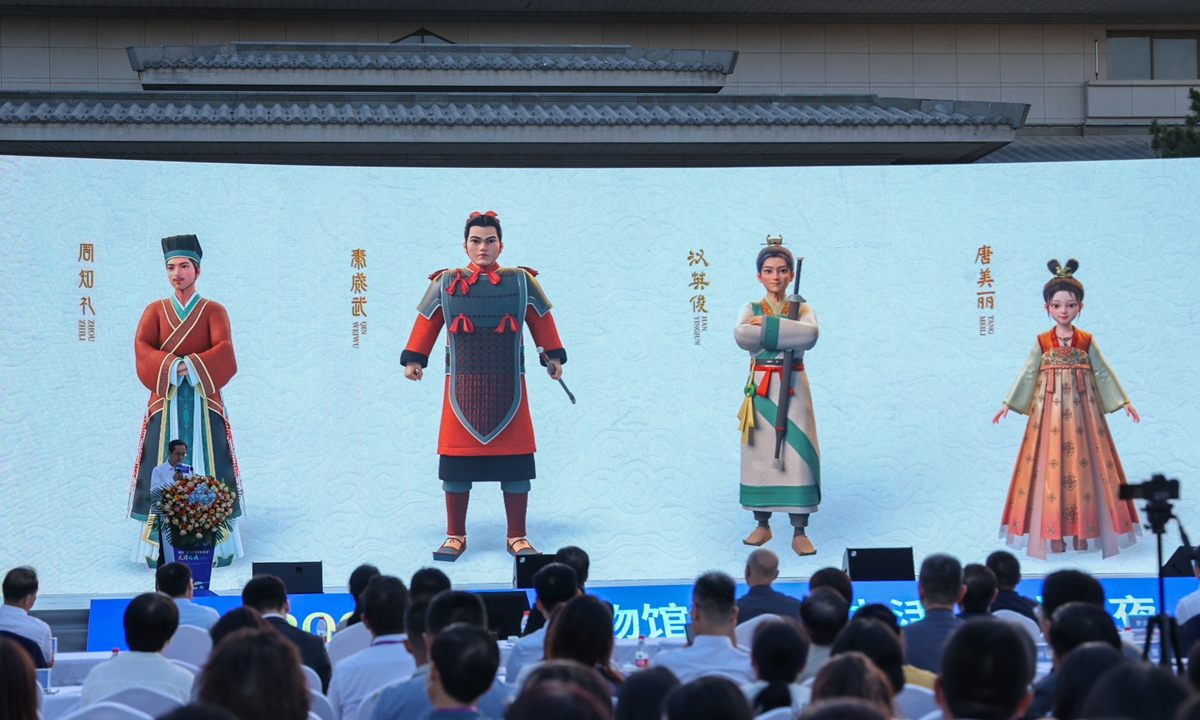
Photo: IC
Earlier this week, the Shaanxi Provincial Cultural Heritage Administration introduced four digital ambassadors as part of its bid to strengthen its digital presence.
A cultural powerhouse, Northwest China’s Shaanxi Province is renowned for its rich cultural heritage and deep historical roots. The capital city Xi’an served as China’s capital for 13 dynasties, including the Western Zhou (1046BC-771BC), Qin (221BC-206BC), Western Han (206BC-AD25) and Tang (618-907) dynasties.
Zhou Zhili, Qin Weiwu, Han Yingjun and Tang Meili are the names of the four digital characters that respectively represent the Zhou, Qin, Han and Tang dynasties.
„Making cultural elements an active part of the internet is vital for the preservation of cultural heritage nowadays,“ Guo Peihui, an official with the Shaanxi Provincial Cultural Heritage Administration, who oversees the digital ambassador program, told the Global Times on Wednesday.
„Digital characters are popular among the young generations. They can help make history and cultural elements easier to understand.“
The digital characters have been crafted to embody the distinct characteristics of their respective eras. For instance, their names in Chinese represent the different cultures of the dynasties.
„Aligning the characters‘ names with their respective personalities and cultural roles can also boost the popularity of the culture of these various dynasties,“ Guo noted, adding this approach aims to enhance people’s cultural perception and facilitate effective cultural dissemination.
As one of the cradles of ancient Chinese civilization, Shaanxi, whose cultural significance and contributions to Chinese history are unparalleled, boasts a wealth of cultural treasures and a profound historical legacy, from the iconic Terracotta Warriors to the ancient Silk Road. This has granted Shaanxi a pivotal role in shaping China’s cultural and historical landscape.
The four digital figures could diversify the way the province’s rich history is presented and is sure to be more effective than relying on one single figure.
„Using one single character will limit the way we can present things digitally, as coordinating the four characters can make interactions with audiences more captivating,“ Guo said.
The digital ambassadors will utilize cutting-edge technology to transcend the limitations of time and space, said Guo, as the characters are expected to have a range of abilities to engage with the audience and offer immersive cultural experiences.
While the virtual characters are still in the early stages of development, their envisioned applications include interactive conversations, presenting historical information, showcasing traditional rituals or customs through animated works and participating in livestreaming broadcasts and programs, Guo said.
Analysts say the virtual characters can bridge the gap between online and offline experiences, attracting more visitors to visit cultural institutions and expanding the boundaries of marketing and cultural tourism, thus fostering a new ecosystem for the cultural industry.
„The project will not only enrich cultural experiences but also propel the development of the cultural industry, combining heritage preservation with utilization and fostering the growth of the cultural creative industry,“ a Beijing-based cultural expert told the Global Times on Wednesday.
„Their future integration into exhibitions and interactive experiences can diversify the way people learn about and appreciate history. By combining the power of storytelling, technology and cultural preservation, putting modern elements into ancient cultural resources could help make our cultural heritage more vibrant both online and offline,“ said the expert.
https://www.globaltimes.cn/page/202305/1291318.shtml
Die Debatte um Diversität und Inklusivität von Minderheiten oder anderen „Rassen“erreicht nun auch China. Die Adaption von der kleinen Meerjungfrau mit nun einer afroamerikanischen Besetzung und braunen Haut stößt auf Kritik. Ob es nun daran liegt, dass eine „Negerin“ statt einer Asiatin gewählt wurde? Das wäre wohl zuviel Eingeständnis eines eigenen Hanchinesenrassismus und das will man sich nicht nachsagen lassen. Daher setzt die Kritik an anderer Ebene an: Ob die Geschichtserzählung klassische Formate einfach durch Quotierungen geändert werden soll und so die Klassiker entfremdet werden sollen, was sie verhungern würde. Klassiker soll Klassiker, Original soll Original bleiben, eher als historisches Zeitdokument, dessen gegebenefalls aktuelle Aussage man auch aus seiner damaligen Zeit verstehen solle und Hans Christian Andersen und die Kleine Meerjungfrau eben Hans Christian Andersen bleiben- egal von der weißen Hautfarbe-unverfälscht, wie man ihn und sie seit Kinderzeiten kennt.Was ja nicht falsch ist, aber umgekehrt jeder modernen Adaption einen Riegel vorschieben würde. Demnach dürfte es Richard Wageners „Ring der Nibelungen“ in Bayreuth auch nur in der traditionellen Urfassung und nicht irgendwelchen Schlingensiefversionen oder modischem Bedienen irgendwelcher Zeitgeisttrends geben, was ja manchmal auch angenehmer wäre. Stattdessen solle man lieber neue Geschichten, die sich mit der wirklichen Perspektiven anderer Minderheiten/Rassen und ihrer Probleme inklusive Rassismus auseinandersetzen schreiben und die Originale nicht einfärben. Die Ernsthaftigkeit des Motivs der Inklusion und Diversität im Westen/USA/Hollywood/Disney werden infrage gestellt, auch ob dies nicht ökonomischen Motiven und opportunistische Bedienung modischer Trends dient oder ernsthaft gegen Rassismus ist. Interessant, dass Desantis sich gerade im Rahmen seiner Antiwokeness mit Disney anlegt. Disney jetzt unter Kritik von 2 Seiten-der KP China und den unwoken US-Rechten. Man darf gespannt sein, wann Sinowood den ersten Uiguren und Tibeter oder Mongolen zum Filmheld und deren Probleme mit dem Hanchauvinismus und Rassismus zum Thema macht oder dann vielleicht von Disney eine Chinesen oder mehr panasiatisch einen Asiaten als Protagonisten fordert. Der Sohn von Fu Manchu von Marvel oder Mulan von Disney war ja auch nicht nach Vorstellung der KP China. Vielleicht überrascht ja dann noch Bollywood mit neuem storytelling.
“‘The Little Mermaid’ shows Disney’s lazy storytelling strategy
By Global Times Published: May 25, 2023 12:15 AM

Illustration: Hang Dachuan/Global Times
Disney’s live-action adaptation of The Little Mermaid is set to be released in the Chinese mainland on Friday, the same day as North America. The film, featuring African-American actress Halle Bailey, has caused a debate about representation in entertainment and highlighted the challenges of adapting beloved, traditional tales.
Currently, The Little Mermaid has received mixed reviews in North America, with a 70 percent fresh rating on Rotten Tomatoes but only a 42 percent fresh rating from top media outlets. Additionally, the film’s Metacritic score has dropped from an initial 61 to 59.
Many who have watched the film during pre-screenings have criticized Disney for lacking imagination and misinterpreting the essence of what made its original children’s film successful.
The rather „poor rating“ looks like its performance in China is not optimistic.
Current pre-sales plus pre-screenings is about 410,000 yuan ($58,193) in the Chinese mainland, and the screen rate for its debut has also dropped from 30 percent to 13 percent.
Many Chinese netizens said that like „Snow White,“ the image of the mermaid princess in Hans Christian Andersen’s fairy tales has long been deeply rooted in their hearts, and it takes a leap in imagination to accept the new cast.
Similar sentiments were echoed by Japanese audiences, with rumors that the comment section on the film’s presale page was disabled due to a backlash. Based on these reactions, it seems unlikely that The Little Mermaid will perform well in East Asian markets.
Disney’s decision to cast a person of color as the lead in The Little Mermaid seemingly was made to break stereotypes and promote equality, but so far, the negative reactions outweigh the positive ones.
This begs the question of whether Disney’s „political correctness“ actions are motivated by capital interests or genuine concern for representation.
Despite the controversy, The Little Mermaid has generated significant buzz online, with the trailer receiving record-breaking views and even inspiring viral videos featuring an AI actress.
According to media reports, the first full trailer promoting The Little Mermaid generated more than 108 million global views in its first 24 hours, making it one of the most watched trailers for any title in Disney’s growing stable of live-action reimaginings, and the biggest for a Disney live-action title since The Lion King in early 2019.
Moreover, the film’s controversy has garnered attention and created a new discourse around classic fairy tales.
Karey Burke, president of Disney’s General Entertainment Content, once vowed to have more inclusivity in the company’s productions – as the entertainment giant works to make underrepresented groups, such as racial minorities, account for at least 50 percent of its regular characters by the end of 2022.
Whether Disney’s „politically correct“ actions are misguided or genuine is up for debate, but it is clear that the film’s controversy has created a new discourse around classic fairy tales and their place in modern society.
The Little Mermaid is just one example. The new Peter Pan and Wendy features a black actress as the fairy Tinker Bell and the live-action adaptation of Snow White stars a Latina actress.
The controversy surrounding Disney’s forced inclusion of minorities in classic films is not about racism, but its lazy and irresponsible storytelling strategy.
If the company truly wants to represent marginalized groups, why not create original stories that reflect their experiences instead of turning classic tales into „sacrificial lambs“ for political correctness?
When the beautiful stories that have accompanied countless children’s childhoods become arenas for racial conflict, they lose their meaning and become devoid of romance and fantasy, replaced by arguments about skin color.
If Disney continues following this path, audiences, especially innocent children will no longer care if the „prince and princess live happily ever after,“ but „what is the skin color of the prince and princess,“ and the fairy tale will lose its magic glory.
https://www.globaltimes.cn/page/202305/1291330.shtml
Die KP China kritisiert Disney auch als Anti-China force, da eine Simpsonserie Kritik an Zwangsarbeit äußerte ,wovon man sich angesprochen fühlte und eine Schmierenkampagne wegen Zwangsarbeit an den Uiguren wittert. Die Simpsons sind zwar in China und weltweit beliebt, aber aufgrund ihrer politischen Satire in autoritären Ländern wie China dann doch sehr oft Opfer der Zensur oder wütender Proteste, zuletzt auch als die Simpsons nach China reisten, um ein kleines chinesisches Mädchen adoptieren zu wollen. Nun auch wieder Erregung wegen des Themas Zwangsarbeit, respektive: Uiguren. Disney solle dies mit Blick auf den chinesischen Kinosupermarkt besser unterlassen und erfreulichere Themen bringen.
Disney’s ‚Simpsons‘ episode smearing China doomed to backfire: experts
By Global Times Published: Feb 08, 2023 11:35 PM

Tourists visit the sand sculptures based on American animated sitcom The Simpsons at Haeundae Beach in Busan, South Korea on May 25, 2017. 10 sand sculptors from 6 countries will demonstrate their skills during a sand sculpture festival from May 26 to 29 at Haeundae Beach. Photo: CFP
After Disney removed a Simpsons episode smearing China from its streaming service in the Hong Kong Special Administrative Region, experts warned on Wednesday that untrue content is a self-defeating move and Disney should better manage its products for the sake of sustainable development in China.
A recent episode of the American cartoon series The Simpsons wantonly smeared China, with a clip referring to the “forced labor camps” in China fabricated by anti-China forces, according to media reports.
The episode, named One Angry Lisa, contains a scene of about 10 seconds in which a character, over images of China’s Great Wall, says “behold the wonders of China. Bitcoin mines, forced labor camps…”
The lines sparked criticism among netizens. A netizen wrote on Facebook that it is unethical and unprofessional. “Too many people rush to judgment based on prior hypothesis bias, and now the West leads the way and turns lies to ‘truth,’” he said.
Based on the US’ strong economic power, American cultural products have great influence across the world, but the influence is not the same as truth and justice, Dong Shaopeng, a senior research fellow at the Chongyang Institute for Financial Studies at Renmin University of China, told the Global Times on Wednesday.
It is a sign of the cultural penetration of anti-China forces in the US, Dong warned.
Anti-China forces in the West have been hyping rumors about “forced labor camps” in Northwest China’s Xinjiang Uygur Autonomous Region in recent years. China’s Foreign Ministry said they are seeking to undermine the prosperity and stability of Xinjiang and contain China’s development and revitalization under the pretext of human rights.
The cartoon series is produced by Disney-owned 20th Television Animation and airs on the company’s streaming platform Disney Plus, which is currently not available in the Chinese mainland. Though Disney has removed the episode from its streaming service in Hong Kong, users from many other regions, such as Australia and China’s island of Taiwan, can still watch it, according to a Financial Times report and Hong Kong media outlets.
Respect for the truth is the most basic requirement, Dong said, noting that wantonly smearing China will eventually backfire.
China has become one of Disney’s most significant sources of revenue for its films and theme parks.
The box office for its latest film – “Avatar: The Way of Water” – has exceeded 1.66 billion yuan in the Chinese mainland, according to data released by the box office tracker Dengta on Wednesday.
During the recent Spring Festival holidays, Shanghai Disneyland was packed with visitors. It took an hour just to get into the park, one netizen said on Chinese social media platform Xiaohongshu.
https://www.globaltimes.cn/page/202302/1285109.shtml?id=11
Scheinbar will man jetzt mittels Tibet etwas von Xinjiang ablenken und dies als Entwicklungsmodell zeigen auch für den Global South, als dessen Führer sich ja China und Indien gebärden. Nun verbindet der Großteil der Weltöffentlichkeit nun Tibet zuerst einaml mit der Person des Dala Lamas als inoffiziellem Führer des Weltbuddhismus , weswegen er und der tibetische Buddhismus gar nicht erst erwähnt werden und die KP China auch das Wort Tibet in ihren englischsprachigen Publikationen nun gestrichen hat und wie im chinesischen nur noch von Xizang redet. Vom Dalai Lama hört man nichts mehr, zumal sich die KP China still und leise auf seinen Tod und Ersetzung seiner mit einem chinesischen Kandidaten vorbereitet, auch nicht von eklatanten Menschenrechtsverletzungen wie den Arbeitslagern bei den Uiguren. Nun wird Tibet als das Paradebeispiel chinesischer Entwicklungserfolge präsentiert auf einem Forum mit ausländischen Vertretern- Angeblich sind jetzt viele Landesteile Tibets mit Bullettrains, Infrastruktueren und Strassen verbunden worden. Die Strecke Peking-Lhasa soll nun auch nach Nepal erweitert werden- deswegen war wahrscheinlich auch ein Vertreter Nepals auf dem Tibetforum. Interessanterweise wollen jetzt auch die Inder eine Eisenbahnstrecke Neu Delhi-Katmandu bauen/Breitspur/Diesel. Dabei müssen sie aber nicht über den Himalaya bauen, wie die Chinesen, die wohl E-Züge mit anderer Spurenbreite haben wollen. Schauen wir mal, wer da zuerst nach Katmandu vorstößt, zumal das ja dann auch wie die Baghdadbahn für Truppentransporte genutzt werden könnte anstatt nur für Hindu- und Buddhapilger nebst Touristen und Geschäftsleuten. Das feudalistische Dalai- Lama- Tibet ist tot, es lebe das ESG (Ecology, Social, Good governance)- Xizang als erfolgreiche Provinz Chinas mit people´s happiness und Bruttonationalglück ala dem buddhistischen Bhutan. In Tibet dann als Xizang nicht mehr God governance durch einen Dalai Lama und den tibetischen Buddhismus, sondern eben good governance durch God Xi und seine Gedanken. Auch die Hans Seidel- Stiftung der CSU reiht sich in den Chor der Bewunderer ein wie einst Strauß bei Mao:
“Xizang’s vitality, prosperity shine at key development forum
‘People’s happiness the ultimate human right; development key to it’
By Zhang Han, Shan Jie , Yin Yeping and Fan Wei Published: May 23, 2023 11:05 PM Updated: May 23, 2023 11:40 PM
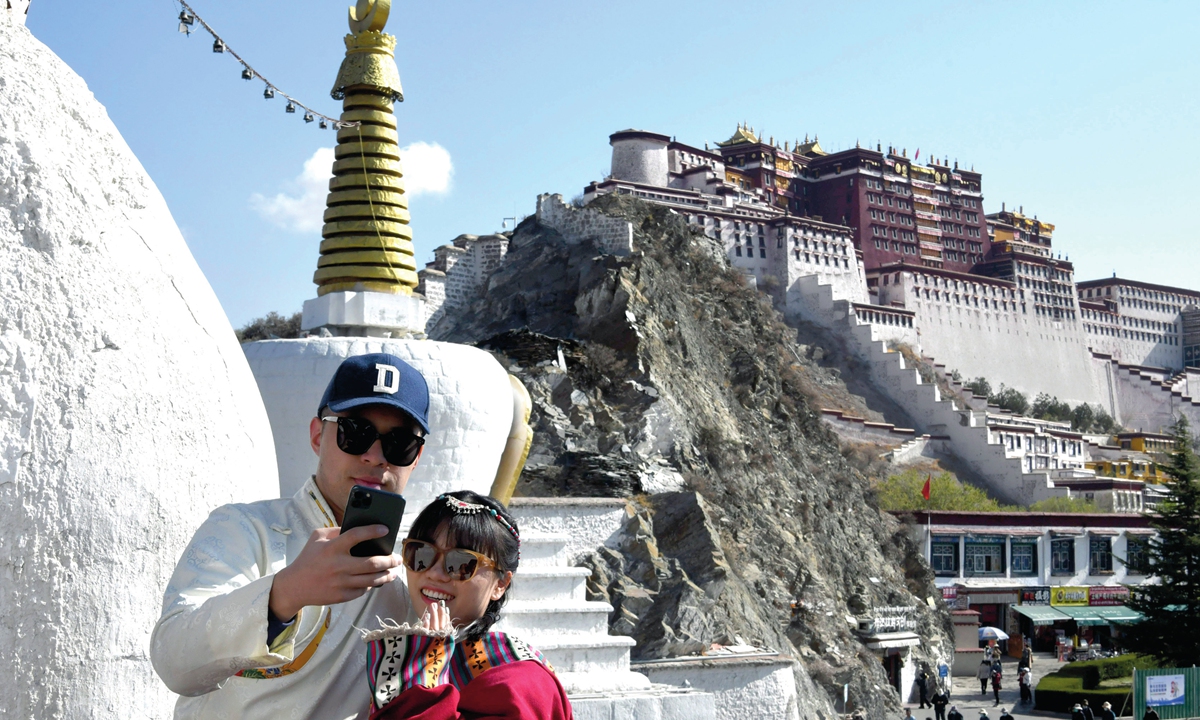
Tourists dressed in ethnic clothing take pictures in front of the Potala Palace in Lhasa, Southwest China’s Xizang Autonomous Region on April 17, 2023. Photo: VCG
People’s happiness is the ultimate human right, while development holds the key to delivering better lives to the people, Chinese President Xi Jinping said in his congratulatory letter to „2023 Forum on the Development of Xizang, China“ held in Beijing on Tuesday, May 23, the 72nd anniversary of the region’s peaceful liberation.
Since the 18th National Congress of the Communist Party of China (CPC) in 2012, people in Xizang, with the strong support of the central government and people throughout the country, have worked with fortitude and brought about a resolution to the problem of extreme poverty that had plagued the region for centuries, the letter said. Xizang has achieved a moderately prosperous society in all respects along with the rest of the country, demonstrating vibrant and thriving scenes.
The vitality and prosperity of Xizang not only impressed more than 150 diplomats, scholars and industry representatives from 36 countries and regions at the Tuesday forum, but also constituted a loud rebuttal to some groundless attacks and smears against China’s policy and governance in Xizang.
Li Shulei, a member of the Political Bureau of the CPC Central Committee and head of the Publicity Department of the CPC Central Committee, also delivered an address to the Tuesday forum.
The Global Times learned from the forum that Xizang’s GDP and GDP per capita reached 213 billion yuan ($30 billion) and 58,438 yuan in 2022, a jump of 347 and 110 times from the time of peaceful liberation 72 years ago. People’s life expectancy doubled from 35.5 years in 1959, the time of democratic reform, to 72.19 years today. People in Xizang enjoy free education for 15 years.
The numbers are the best illustration of Xizang’s achievements in development and human rights protection, said Yan Jinhai, Deputy Secretary of the CPC Xizang Autonomous Regional Committee and Chairman of the People’s Government of Xizang Autonomous Region.
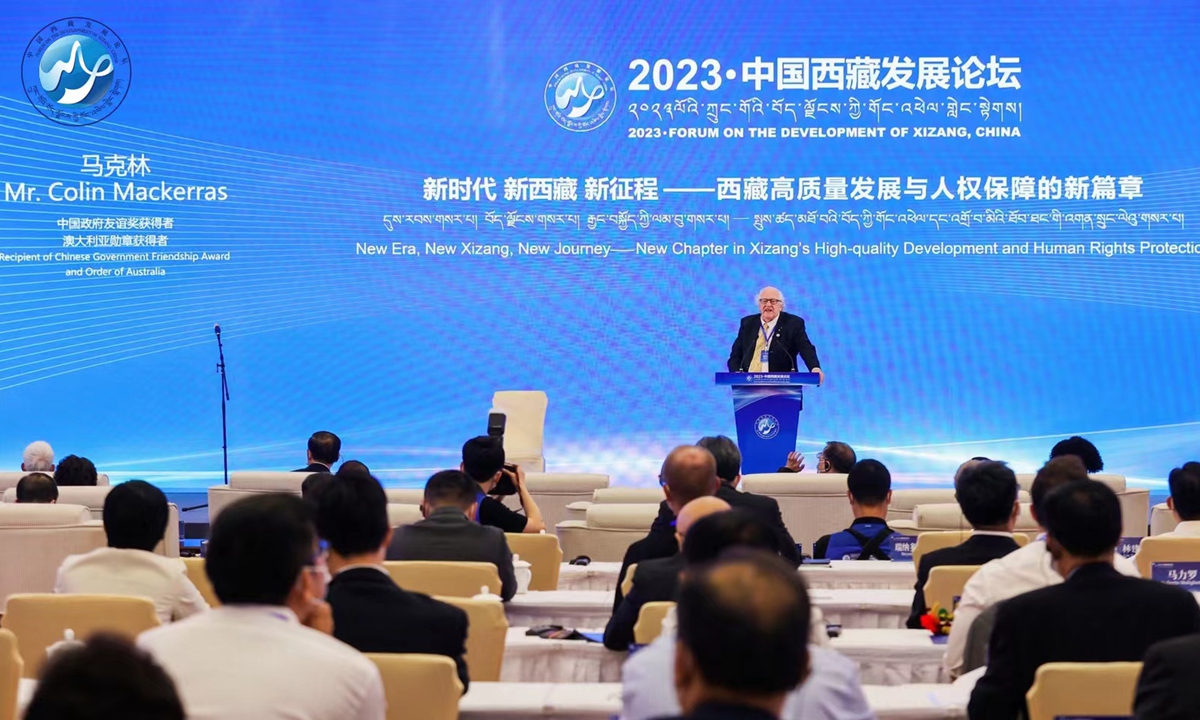
The 2023 Forum on the Development of Xizang, China kicks off in Beijing on May 23, 2023. Photo: Zhang Han/ GT
Impressive achievements
After visiting Xizang Autonomous Region, foreign delegates hailed the region’s modernization from infrastructure progress to economic leaps, while being impressed by the effective protection of local culture and ecological preservation.
The delegation took a high-speed train from regional capital Lhasa to Nyingchi, Xizang’s first electrified railway that opened in 2021. Many forum attendees mentioned the experience to the Global Times as a vivid example of Xizang’s high-quality development.
In Xizang, remote cities are connected through bullet trains, roads and other transportation, which established the basis for economic development, Nepali Ambassador to China Bishnu Pukar Shrestha told the Global Times at the event.
Maria Gustava, the Mozambique Ambassador to China, in her speech at the forum opening ceremony hailed a modern Xizang that has well-connected infrastructure as well as advanced telecommunications systems, including 5G internet.
Gustava told the Global Times that through Xizang’s development miracle of poverty alleviation, she saw the philosophy of inclusiveness – each region should develop based on its own conditions and protect and preserve local cultures. African countries can learn from China’s experience and further cooperate on poverty reduction and rural development, she said.
Alexander Birle, chief representative of Germany’s Hanns Seidel Stiftung in China, told the Global Times on Tuesday that Xizang’s development focus is not only on the economic aspect, but also ecological protection and the preservation of cultural relics and heritage.
Xizang is a strategic national ecological security barrier and a national experimental area for green development. Efforts include monitoring of glaciers, constructing national parks and reserves, accelerating the green transformation in industry and society and preserving the invaluable land, according to the forum.

Thirteen Chinese scientists display the Chinese national flag on the summit of Mount Qomolangma after reaching the summit on May 23, 2023. After that, they are expected to complete important scientific tasks such as collecting snow and ice samples from the summit. This is the first time that China’s Everest expedition has reached an altitude above 8,000 meters since 2022. Photo: Xinhua
Breaking stereotypes
The development of Xizang is evident for all to see, yet it has always been accompanied by noises from the outside world. Some Western media or politicians turn a blind eye to the facts of Xizang’s development and instead engage in deliberate slander. Some arguments are baseless and merely serve as a tool to attack China.
One recent clamor from the West and anti-China forces revolves around accusations leveled at boarding schools in Xizang. Recent reports claim that „the Chinese government is attempting to eradicate Tibetan culture altogether.“
However, the Global Times visited boarding schools in Xizang at the end of March, and the reality is quite different – Tibetan language education and the preservation of traditional culture are integral parts of education in Xizang, and they are well-reflected in boarding schools.
Boarding schools are suitable for Xizang’s unique geographical environment as they provide formal education to students from remote areas, holding significant importance in nurturing more talents locally.
Vikash Kumar Singh, a lecturer at the Asia Institute of Beijing Foreign Studies University from India, told the Global Times on Tuesday that people in Xizang stick to their own traditions and culture, like their dances, music, food and Thangka painting, in opposition to Western claims that Xizang culture is in danger.
Xizang is keeping its traditions while developing, and Xizang people also have the right to offices with air conditioning, cinemas and bullet trains, Singh said.
The „Tibetan government-in-exile“ and some overseas anti-China organizations try to use religion, „human rights“ and other topics to undermine social stability in Xizang, but Abdilahi Ismail Abdilahi, a teacher at Beijing Foreign Studies University from Somalia said „When you arrive in Xizang, you can realize that everything is different from what you have heard in some media.“
„As long as you get to Xizang and see with your eyes, you could realize what is going on in Xizang,“ he said, noting that the experience of Xizang’s development could also inspire that in African countries.
Guillaume Guibe, a French employee of China Petroleum & Chemical Corporation said that the criticisms and stereotypes in the West about Xizang come out of ignorance. „They [some people in the West] just hear some stories about Xizang and do not check these stories,“ Guibe said. „I wish they could someday visit the region by themselves.“
Zhang Shuhua, director of the Institute of Political Sciences at the Chinese Academy of Social Sciences, told the Global Times at the forum that some concepts, including human rights and democracy, are used by anti-China forces deliberately to attack China’s governance.
China’s human rights should be understood in the broad context of the success of China’s governance, which is realized by sticking to a political path suitable for historical and cultural conditions, by upholding the leadership of the CPC to ensure that its governance always has a stable political core, and by adhering to the „people-centered“ principle, Zhang shared at the forum.
As long as sound governance continues to bring substantial development in Xizang and the rest of China, all attacks on human rights and democracy would fall through, analysts said.

GT Graphics
https://www.globaltimes.cn/page/202305/1291241.shtml
Aber Xizang ist da nicht nur eine Sache Erwachsener, sondern auch ein Generationenanliegen und Megaaufgabe für die chinesische Generation Z.Denn auch für diese gab es ein eigens Forum. Wohl die staatlich initiierte FFF-Variante Fridays for Xizang. Tibet jetzt als Klimaschutzprojekt für die Generation Z-ob jetzt Chinesen oder auch Tibeter wird da nicht gesagt. Jedenfalls sei Tibet reich mit Sonne, Wasserkraft und Kohle gesegnet und wolle man da die erneuerbaren Energie ausbauen. Nationalparks anlegen, die Biodiversität schützen, invasive Tierarten abhalten und etwas gegen die Gletscherschmelze tun .Freilich könnte die Generation Xi selbst sehr schnell etwas zum Klimaschutz tun, wenn sie auf die zusätzlich geplanten Hunderten neuen Kohlekraftwerke und etwas Wirtschaftswachstum verzichten würde, was aber gar nicht zur Debatte steht und jeden, der das äußert zum Oppositionellen oder Dissidenten mit bekannter Behandlung durch Chinas Stasi machen würde:
“Gen Z could play significant role in Xizang’s sustainable development: forum
By Shan Jie
Published: May 23, 2023 09:55 PM
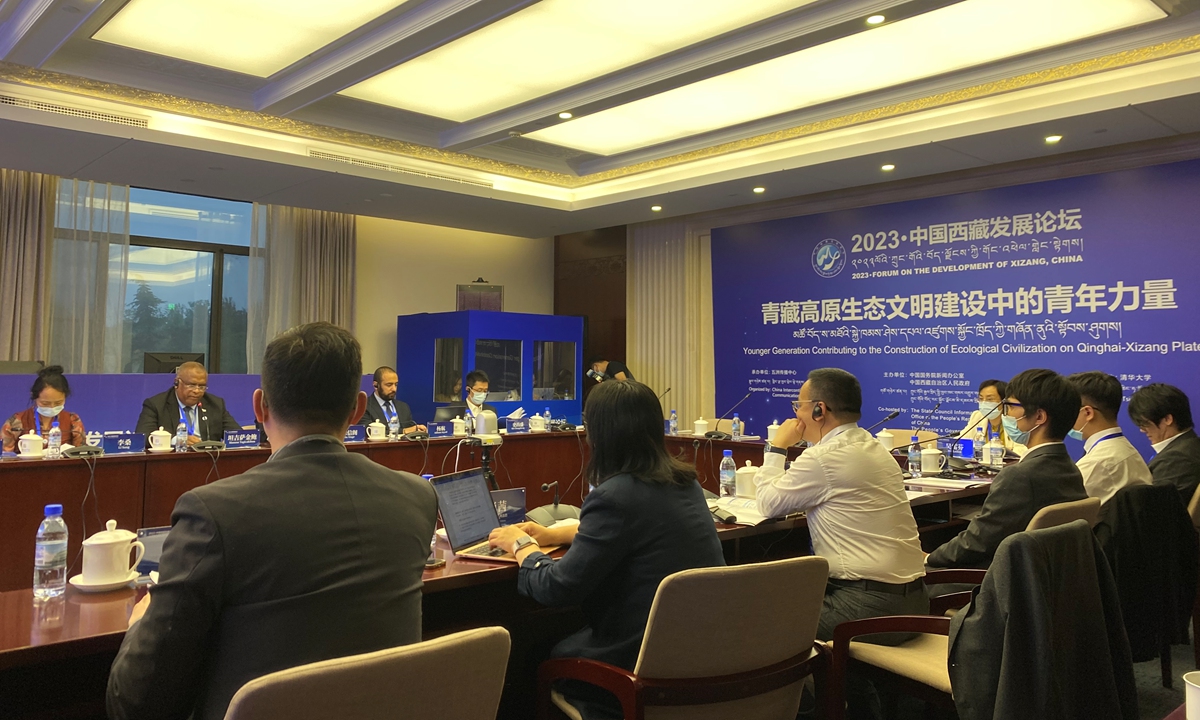
Experts and young scholars share their opinions on the topic of „Younger generation contributing to the construction of ecological civilization on Qinghai-Xizang plateau“ at a side event at the Forum on the Development of Xizang held on May 23, 2023 in Beijing. Photo: Shan Jie/ GT
The younger generation is actively engaged in the conservation of the ecology and environment in Southwest China’s Xizang Autonomous Region, and many more Gen Z people with diverse skills and abilities are expected to contribute and take on significant roles in this endeavor.
Environmental authorities, experts and young scholars shared their opinions on the topic of „Younger generation contributing to the construction of ecological civilization on Qinghai-Xizang plateau“ at a side event at the Forum on the Development of Xizang held on Tuesday night in Beijing.
„The young generation should be guided well in terms of preserving ecology, because the ecology gives back to them,“ Manasa Tagicakibau, Ambassador of Fiji to China, told the Global Times at the event.
The ambassador noted that both the South Pacific and Xizang are vulnerable to climate change. „We have frequent storms, tropical cyclones that are happening more frequently and with greater intensity now due to climate change, while glaciers are melting in Xizang, causing the sea level to further rise,“ he said.
The responsibility and practice of „Generation Z“ in promoting environmental protection and sustainable development in the Qinghai-Xizang Plateau are crucial to the future of the region and the planet as a whole, Jennifer Holstein, principal of the International Education School of Pingo Academy, said.
„Generation Z can make a significant impact on the environment and contribute to a more sustainable future. It is up to this generation to take action now to ensure that the Qinghai-Xizang Plateau remains a vibrant and healthy ecosystem for generations to come,“ she said.
Xizang has seen achievements in ecological protection, and it is expected to benefit more from the process of green development.
„Xizang is blessed with abundant natural resources. It holds a unique advantage in terms of hydroelectric and solar energy potential, with the highest development capacity and carbon sequestration capacity in the country,“ Yan Jinhai, Deputy Secretary of the Communist Party of China Xizang Autonomous Regional Committee, Chairman of the People’s Government of Xizang Autonomous Region, said in his plenary speech at the forum.
In the future, there is a strong possibility of establishing a clean energy base with a total capacity of more than 300 million kilowatts. This would provide trillions of kilowatt-hours of clean electricity to the nation annually, contributing to a reduction of approximately 1 billion tons of global carbon dioxide emissions.
Xizang is home to the most developed mountain glaciers, abundant rivers, and lakes. It is one of the world’s three major pristine regions, with large parts of the area still in its original state and numerous ecological secrets yet to be unveiled, Li Sang, Vice Party Secretary and Director General of the Ecological Environment Department of Xizang Autonomous Region, said at a sub forum on Tuesday.
Xizang will promote the establishment of the Three Rivers Source National Park (Tangbei region) and facilitate the development of national parks such as Qiangtang and Mount Qomolangma. Efforts will be made to enhance the protection and management of biological genetic resources while strictly controlling the invasion of alien species, according to Li.
https://www.globaltimes.cn/page/202305/1291227.shtml
Für die zentrale zukünftige Aufgabe der Gen Z in der Auseinandersetzung mit den USA wird auch dem letzten vermeintliche Sieg von Chinas VBA gegen das US- Militär im Koreakrieg gedacht und die Bevölkerung nun mit einer neuen Kriegsschwarte Patriotismus und Opferbereitschaft fürs Vaterland eingeimpft. Dabei wird der Stolz auf die rote Kultur herausgestrichen.
„Action epic to bring heroism in Korean War to modern era„Action epic to bring heroism in Korean War to modern era
New war film inspired by pivotal blockade battle
By GT staff reporters Published: May 22, 2023 11:22 PMhttps://www.globaltimes.cn/page/202305/1291164.shtml
Um den scheinbar etwas frustrierten Teilen der Jugend der Gen Z mit „No Future“- und „Null Bock“-Tendenzen da etwas Orientierungshilfe zu geben und „Sinnangebote zu stiften“, hat man jetzt noch einen eigenen Propagandafilm „Brennende Jugend“ gedreht, wie denn die Gen Z nach Vorstellung der KP China als neue idealtypische Jugendpioniere auszusehen hat. Vom Pandabrüter über den insularen Bewacher des Südchinesischen Meers bis zum Taikonauten wird da alles offeriert und als Vorbild und Zukunft herausgestellt. Ob es solche Filme auch im Westen gibt? Vielleicht geht das ja mal über Jugend forscht, Praktikumsbörse und Girlie Day hinaus und ist ja vielleicht im Rahmen der Zeitenwende dann ein staatlicher Propagandafilm von Traumberufen vom Soldaten bis hin zum Wiederaufbauhelfer in der Ukraine dann das Thema, da dies ja auch laut Scholz eine „Generationenaufgabe“ werden soll.
“’Burning Youth‘ puts China’s Generation Z in the spotlight
New variety show tells ‚dare to dream‘ stories
By Xu Liuliu
Published: May 04, 2023 10:44 PM

Photo: Courtesy of Tencent Video
Young panda breeders whose daily job is to prepare three meals a day for these cute creatures, conservationists who dive under the waters of the South China Sea to tie coral to the seedbed and soldiers who guard the border in Southwest China’s Xizang Autonomous Region… They are some of the millions of China’s Generation Z who are daring to dream and take action.
Burning Youth, a new variety show focusing on these stories, debuted on streaming platform Tencent Video on Thursday, China’s Youth Day.
„They are just ordinary people living among us,“ show producer Zhang Wei told the Global Times.
According to its director Wang Ning, each episode focuses on different themes, such as „Dreams,“ „The path toward dreams“ and „Our choices,“ presenting two to three stories that expand on these themes.
„Each youth story aims to grab the public’s attention. A story ‚finder‘ will ‚walk through‘ the story and introduce it to audiences. With this approach we are striving to find a means of presentation that young people love to see and that can present the depth and breadth of each story,“ Wang said.
Stories will focus on people like Yang Cen, the youngest female large-diameter shield machine driver in China, and Deng Manqi, daughter of Chinese taikonaut Deng Qingming and an assistant engineer at the Beijing Aerospace Control Center.
The „Our choices“ theme will introduce the stories of Dou Xiaoxuan, a national first-class actor from the Mei Lanfang Peking Opera Troupe at the Beijing Peking Opera Company; Wang Xiuzhen, who built the largest passion fruit sorting and sales center in her county; and the Saihanba forest rangers, who turned a wasteland into a forest in North China’s Hebei Province.
The show aims to be an exploration variety show that observes and records the inspirational stories of young people. Through the unique youth perspective of young people, it extracts the youth stories of „dare to think and to do and doing it well,“ and presents all walks of life to work hard for the motherland.
According to Yin Hong, a professor at the School of Journalism and Communication of Tsinghua University and vice chairman of the China Literature and Art Critics Association, a variety show should convey positive energy and mainstream values while combining entertainment and education.
„The show uses relatively unfamiliar themes to arouse empathy in viewers as they watch ordinary young people use their lives and youth to write valuable stories,“ he said.
„That is a very good basis for high quality content, which requires creators to discover truth, goodness and beauty in life and turn to themes that lead people upward, toward goodness and to chase beauty. These three are the most valuable things in life.“
https://www.globaltimes.cn/page/202305/1290145.shtml
Denn die chinesische Generation Gen Z scheint sich da teilweise für eher andere Sachen recht nachhaltig zu interessieren, speziell für Tiktok und Influencer mit destruktiven Verhaltensweisen, die nicht dem KP Chinageschmacke gefallen, wohl auch im Westen Anstoß erregen würde, wobei das BILD mal wieder als Argument gegen die chinesische Konkurrenzfür US- Influencerplattformen nimmt und so tut, als sei Koma- und Wettsaufen ein chinesisches oder gar asiatisches Alleinstellungsmerkmal bei vielen Jugendlichen:
„Alkohol-Exzess auf TikTok Chinese stirbt nach Trink-Livestream

Wang Moufeng kam aus der Provinz Jiangsu im Nordosten Chinas. Diese Bilder sollen ihn bei seinem tödlichen Besäufnis zeigen
Foto: Douyin
Tödliche Trink-Orgie auf TikTok!
Der chinesische Internet-Star Wang Moufeng (34), besser bekannt als „Brother Sanqian“, ist tot. Bei einem Livestream-Wettbewerb soll er vergangenen Dienstag massenhaft Schnaps getrunken haben und daran gestorben sein, berichtet die britische
BBC. All das sei auf Douyin passiert – der chinesischen Version von TikTok.
Zwölf Stunden nach seinem Stream wurde der Influencer tot in seiner Wohnung aufgefunden. Wangs Tod könnte mit hoher Wahrscheinlichkeit auf eine Alkoholvergiftung zurückzuführen sein. Am Samstag fand seine Beerdigung statt.
„Als seine Familie ihn fand, war er bereits tot. Er hatte nicht einmal die Chance auf eine Notfallbehandlung“, sagte ein enger Freund gegenüber Shangyou News.
In China wird meist zu hochprozentigem Alkohol gegriffen. Wang trank in seinem Stream die farblose Spirituose Baijiu, welche bis zu 60% Alkohol enthält. Normalerweise wird Baiju in fingerhutgroße Schnapsgläser gefüllt. Wang soll bei seinem Besäufnis jedoch mindestens sieben volle Flaschen getrunken haben, berichten Zuschauer.
Zum Vergleich: Eine Whiskey-Flasche „Jack Daniel’s“ hat einen Alkoholgehalt von 45 %.
Worum ging es bei dem Wettbewerb?
Wang hatte am vergangenen Dienstag an vier sogenannten „One-on-One-Battles“ teilgenommen. Bei dem Spiel feuern Influencer jeweils die eigene Community an, um möglichst viele virtuelle Geschenke zu erhalten. Diese werden mit echtem Geld finanziert. Der Spieler, der innerhalb kürzester Zeit mehr Punkte bekommt, gewinnt. „Brother Sanqian“ verlor jedoch drei der Runden und musste zur Strafe trinken.
Auf Douyin gilt striktes Alkoholverbot. Wang selbst war in der Vergangenheit schon öfter wegen Alkoholkonsums verbannt worden. Mit neu angelegten Nutzer-Konten mogelte er sich aber immer wieder zurück auf die Plattform. Bis zu seinem Tod folgten ihm etwa 44 000 Menschen.
Der Tod von Wang ist kein Einzelfall! Immer wieder sterben chinesische Influencer während ihrer Arbeit. Im Jahr 2021 erging es auch dem Streamer Yu Hailong (29) so. Der Streamer war durch exzessives Essen bekannt geworden. Dieser gefährliche Trend aus Südkorea nennt sich Mok-Bang.

Im Jahr 2018 starb auch der Livestreamer „Dafei“, der dafür bekannt war, vor laufender Kamera Alkohol und Speiseöl zu trinken.
Nun nimmt man sich nach der Kampagne gegen Celebrities und Fancluns in der Global Times den Influencern an. Der geschilderte Verhaltenskodex ist so schön allgemein, dass er auch von der EU oder den USA verfasst sein könnte. Interessant ist,dass der einzig konkret genannte Fall eine Art Metoo-Vorwurf einer Influencerin über sexuelle Belästigung durch einen CEO ist. Scheinbar will man nach Peng Shuai nun einem Metoo-Tsunami und anderen chinesischen Weinsteins, Brüderles und Kachelmanns vorbeugen
“Maintaining integrity great responsibility for influencers
By Global Times Published: May 23, 2023 10:12 PM

Illustration: Hang Dachuan/Global Times
The rise of influencers has transformed the way we consume content and engage with social media platforms. These individuals, often known as online celebrities, wield significant influence over their followers, shaping opinions and trends with a single post or video. However, with great power comes great responsibility, and it is imperative that we establish a code of ethics to guide these online personalities.
The recent case involving online influencer Xiaohuijun and her false allegations against a multi-channel network company highlights the need for online celebrities to adhere to legal and ethical standards.
The influencer, with 13 million online followers, accused the company’s CEO Sun Haoyu of sexual harassment and forcing her to sign a contract, prompting widespread attention and controversy.
This case serves as a stark reminder that we must differentiate between legitimate claims and baseless accusations. Upholding the principles of lawfulness, responsible speech and ethical behavior should be the fundamental requirements for anyone publishing contents on the internet.
Freedom of speech is essential, but it must be exercised responsibly, with consideration for the potential consequences of one’s words and actions.
The role of influencers in shaping public opinion cannot be underestimated.
Their vast followings and ability to sway trends and opinions have led to their exploitation by different online groups and communities. It is crucial to guard against the misuse of their influence and the manipulation of public discourse. Influencers should not allow themselves to be entangled in misinformation or become pawns in the hands of those with ulterior motives.
Compliance with laws and responsible speech should be the basic minimum standard. Influencers must recognize their role as influencers and understand the impact their words and actions can have on their followers. By becoming influencers, they have a responsibility to ensure that the information they share is accurate, verified, and aligned with legal and ethical standards. Only in doing so can they help create a healthier online environment built on trust, reliability, and transparency.
To prevent the proliferation of fake news and the spread of harmful rumors, it is essential for online influencers to verify the accuracy of the information they share before disseminating it to their audience. Fact-checking and critical thinking should become an integral part of their content creation process. By adhering to these principles, they can play a pivotal role in countering the spread of misinformation and promoting a culture of truthfulness and integrity.
Furthermore, influencers should be cautious about becoming involved in controversies without fully understanding the underlying facts and complexities of the situation. They should exercise restraint in making public statements or taking sides until all the relevant information has been thoroughly examined and verified. Premature judgments can lead to the perpetuation of falsehoods, further polarize public opinion, and damage their own reputation in the long run.
The abuse of influencer status and manipulation of public opinion should be strongly condemned. Internet influencers should resist the temptation to exploit their fame and influence for personal gain. Instead, they should use their platforms to foster meaningful discussions, raise awareness about important social issues, and inspire positive change. By doing so, they can set an example for their followers and contribute to the overall betterment of society.
The case of Xiaohuijun and the ensuing controversies emphasize the importance of upholding integrity and ethical conduct on influencers. Compliance with laws and responsible speech should be the fundamental principle on the internet. It is crucial for them to use their platforms responsibly, ensuring the accuracy and veracity of the information they share. By maintaining high ethical standards and resisting the misuse of their status, they can contribute to a more trustworthy and responsible online community.
https://www.globaltimes.cn/page/202305/1291232.shtml
Ich dachte immer China würde wie wir unter einem Fachkräftemangel wegen demographischer Lücke leiden ,deswegen erstaunt die hohe Zahl von 20% Jugendarbeitslosigkeit. Laut Professor Van Ess, aber wie in Deutschland und auch eiigen westlichen Staaten auch Folge einer Überakademisierung. Aber Langzeitarbeitslose werden das wahrscheinlich auch nicht werden. Sind die dann wirklich so besorgt um ihre Zukunf?
Ist das eine neue Volksfrömmigkeit,wo doch selbst viele Studenten vor der Gaokao auch schon zuvor Tempel besuchten,um auf ein gutes Prüfungsergebnis ein paar Räucherstäbchen anzuzünden? Oder ist das Neue,dass sie das jetzt nach der Gaokao tun? Wobei ja scheinbar nicht nur Akademiker gemeint sein dürften. Erodiert da das Wohlstandsversprechen und die Zukunftsaussichten wie bei uns? Die KP China scheint dies auch noch nicht sonderlich alarmierend zu finden. Scheinbar glaubt man nicht, dass sich da eine volksfromme Bewegung ala Falungpng mit dann 100Millionen Mitgliedern und Demo vor dem Beidahe ergeben könnte, zumal die auch nicht organisiert sind oder scheinen. Umgekehrt könnte aber das verbliebene Untergrundsnetz der Falungong versuchen da anzusetzen. Aber auch möglich, dass die KP China das in ihren parteigelenkten Volksbuddhismus kanalisiert und der züchtet ja brave gehorsame Unteranen, die sich im Extremfall nur selbst verbrennen. Aber so begann auch mal der Arabische Frühling in Tunesien, aber davon dürfte China meilenweit entfernt sein.
„Arbeitslosigkeit in China : Kinder wollen sie in diese Welt nicht setzen
Von Jochen Stahnke, Peking Aktualisiert am 21.05.202
Endliches Glück: Am Lama-Tempel in Peking zünden junge Chinesen Räucherstäbchen an.
Endliches Glück: Am Lama-Tempel in Peking zünden junge Chinesen Räucherstäbchen an.
Wenn du Gehorsam zeigst, steigst du auf – so lautet das Versprechen Pekings an sein Volk. Junge Chinesen ziehen es in Zweifel. Manche fangen an zu beten.
Der Lama-Tempel im Zentrum von Peking ist voller Studenten. Am Tempelkiosk holen sich die Studenten bündelweise Räucherstäbchen ab, zünden sie in einem metallenen Holzkohleofen an und schwenken das Rauchwerk mit gefalteten Händen in alle Himmelsrichtungen. Manche grinsen, aber die meisten blicken ziemlich ernst. Dann gehen sie vor die Halle des unendlichen Glücks, knien nieder und beten für eine bessere Zukunft.
Die offizielle Arbeitslosenzahl unter jungen Chinesen ist in den Städten auf 20,4 Prozent gestiegen. Betende Studenten werden mehr in Peking. Die Behörden nehmen die aufkeimende Volksfrömmigkeit offenbar vorerst hin. Es ist ein Ventil für wachsende Sorgen. Manche fragen sich, ob sich Leistung noch lohnt.“
Nachdem die FAZ nun auch über 20% Jugendarbeitslosigkeit in China berichtete, sowie einer neuen Volksfrömmigkeit und Besuche Chinas Jugend von Tempeln, wird auch dem Rechnung getragen. Buddhistisch-kommunistisches Merchandising in der Marktwirtschaft mit chinesischen Besonderheiten. Nicht nur die traditionellen angestaubten Ladenhüter für ältere Buddhisten, sondern nun auch Talismane, Glücksanhänger, Tassen und was das jugendliche Kitschherz so alles begehrt. Aber die Preise für die Jugendsouvenirs werden da kritisiert und ob man das der auch durch die Corona Lockdowngeschädigten Jugendlichen der Gen Z als nächstes zumuten soll, wenn man schon ihre psyschischen Schäden als Generation Corona nicht an staatlicher Kritik dieser Maßnahmen, wie sie massenhaft in China ausbrachen im Tempelbesuch und Hinwendung zum Opium des Volkes vorerst zu tolerieren scheint. Scheinbar gibt es doch nun zunehmend jüngere Tempelbesucher, wie der Bericht der FAZ über Chinas Jugendarbeitslosigkeit schon behauptete und gar von einer neuen „Volksfrömmigkeit“ unter Chinas Jugend und der Gen Z sprach. Auch interessant, dass Tibet jetzt auch als Zukunftsmodell der Entwicklung für die Gen Z erkoren wird, auch in Sachen Klimaschutz FFF staatlich initiiert und kontrolliert mit chinesischen Besonderheiten.
“Chinese temples attracting young people with trendy, well-designed products
Getting creative
By Huang Lanlan in Shanghai Published: May 24, 2023 09:08 PM
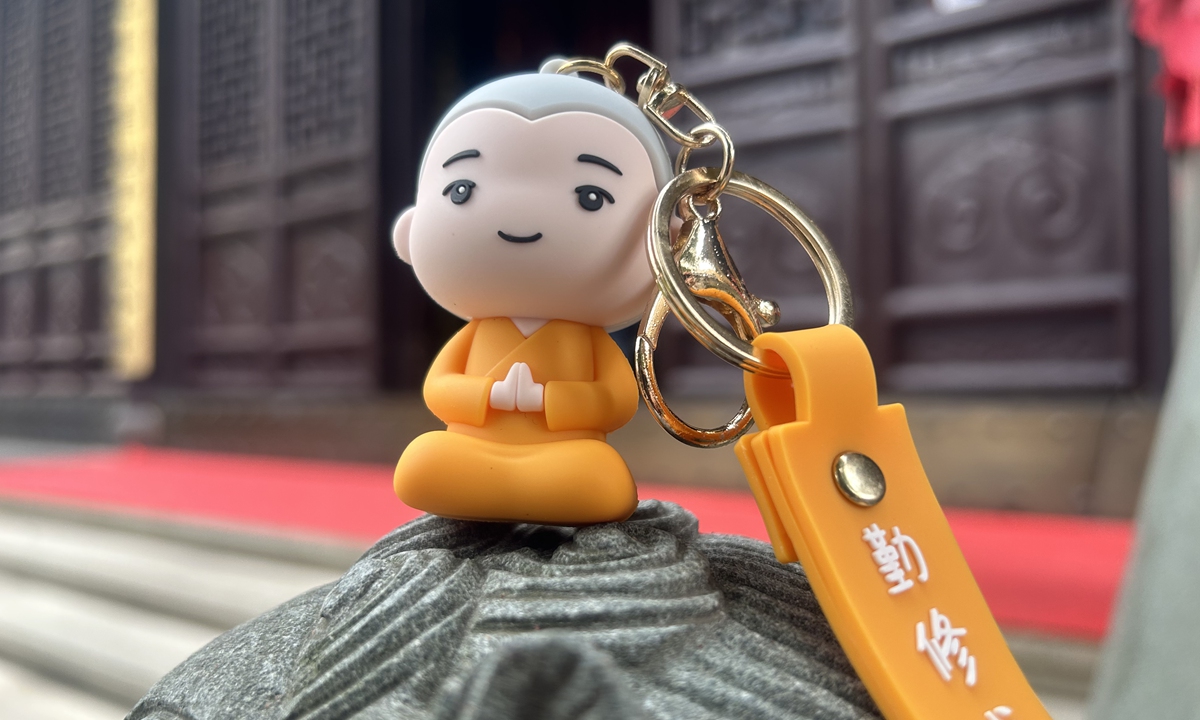
A key chain featuring the cartoon figure Shixiaobai on sale at the Yufo Temple in Shanghai Photo: Huang Lanlan/Global Times
To buy one of Yonghe Lama Temple’s beaded bracelets, Shanghai woman Liang Yu deliberately took time out during her busy business trip to Beijing to wait in line in the cold for more than an hour in front of the temple’s store.
It was an ordinary Monday afternoon in March when Yonghe Lama Temple’s beaded bracelets started gong viral on Chinese social media. The centuries-old Buddhist temple in downtown Beijing has been flooded with visitors even during the weekdays ever since. Including Liang, many of them waited in long queues to buy the popular bracelets, which they believed can bring them good luck, or at least help cheer themselves up.
Visiting temples has recently become a new trend among some young Chinese. They are motivated by such purposes as relieving stress or wishing for good fortune.
Due to this trend, many Chinese temples have started to offer creative and well-designed products to meet the tastes of young visitors.
Instead of the traditional items sold at temples, like Buddhist scriptures and amulets, new products include cups, pens and ornaments that have more secular uses, many of which cleverly combine Buddhism with designs such as cartoon figures and traditional Chinese culture.

Yonghe Lama Temple Photo: VCG
Bestseller bracelets
Liang bought 10 bracelets at the temple for herself and her friends that afternoon, each of which cost nearly 400 yuan ($56).
The temple offers several types of beaded bracelets in various colors that are supposed to improve people’s fortunes for things like their health, career and relationships.
„I bought one for my career,“ Liang told the Global Times.
She said that the Yonghe Lama Temple, the former residence of two Qing Dynasty (1644-1911) emperors, is generally believed to be a good destination for making career-related wishes.
More temple products are designed to directly serve people’s daily life nowadays.
Over the weekend at Yufo Temple, or Jade Buddha Temple, a famous Buddhist temple located in central Shanghai, visitors crowded in the temple’s store, selecting commodities piled up on the shelves such as ink pens, teacups and key chains.
Among the various products, a 99 yuan gift box for students is a bestseller, according to one shop employee. The box contains four ink pens, a silk sachet and a badge with a cartoon image of the Bodhisattva of Wisdom, Manjusri, on it.

Teacups featuring the cartoon figure Shixiaobai on sale at the Yufo Temple in Shanghai Photo: Huang Lanlan/Global Times
Traditional culture elements
Another popular cartoon figure sold at Yufo Temple is of a little monk named „Shixiaobai.“
„Shixiaobai is a cartoon character invented and designed for our temple’s products,“ the Yufo Temple shop employee told the Global Times.
Products sporting Shixiaobai have proven popular among younger customers, she added, pointing toward another big seller on the shelf – a 68-yuan teacup with Shixiaobai’s picture on it.
Similar to Yufo Temple, in recent years some other temples have designed cartoon characters for their products to attract younger customers.
One of the earliest and most famous characters is Xian’er, a cartoon monk originally created by Beijing’s Longquan Temple in 2011. Through the years, Xian’er has been used for various Longquan Temple-related products, from small ornaments to storybooks and even television cartoons.
Apart from cute cartoon images, traditional Chinese culture is also a major feature of recent temple creative products. The Wenshu Monastery, or Monastery of Manjusri, in Chengdu, Southwest China’s Sichuan Province, for instance, has launched a series of products made using intangible cultural heritage skills, such as a porcelain teacup wrapped in a woven bamboo cover, an intangible heritage item unique to Sichuan known as porcelain-bodied bambooware.
Chinese temples are moving with the times, said Buddhist enthusiast Bai Ze, who is also an independent temple product designer working with several temples in East China’s Jiangsu Province.
„As younger monks join temples, they bring new ideas, allowing temples to innovate their designs,“ Bai said.
Bai found that small-sized and good-looking products are a favorite of young customers.
„They are happy to pay for those beautiful and portable things with auspicious meaning,“ she told the Global Times.
Controversial prices
However, controversy has sometimes occurred with the going popularity of these creative products.
Grumbles about unreasonable prices are occasionally seen on social media. On the Twitter-like Sina Weibo, a user complained that she bought a rabbit-shaped key chain accessory for 88 yuan at a temple in Shanghai, but later found a similar item without the temple’s logo for only 10 yuan on a shopping website.
A few products even charge a „pink tax“ from female customers. Liang said the beaded bracelets she bought at Yonghe Lama Temple have men’s and women’s versions. „The women’s bracelets are smaller than the men’s, but they are sold at higher prices,“ said Liang, who founded nonprofit foundation Stand By Her to help women in need.
„That’s not fair.“
Temples are going commercial, which brings profit that allows them to keep running, but it brings new problems as well, Bai said.
Nonetheless, for most customers, price is not their top consideration when buying temple creative products, she added.
„They buy to wish for good fortune, or at least to get in a better mood.“
https://www.globaltimes.cn/page/202305/1291305.shtml
Jedenfalls werden muslimische Moscheen in Xinjiang nun geschlossen und touristischen Zwecken übergeben:
“Uighur mosques closed by Beijing, handed over for tourist use
By ATSUSHI OKUDERA/ Correspondent
October 15, 2020 at 19:15 JST
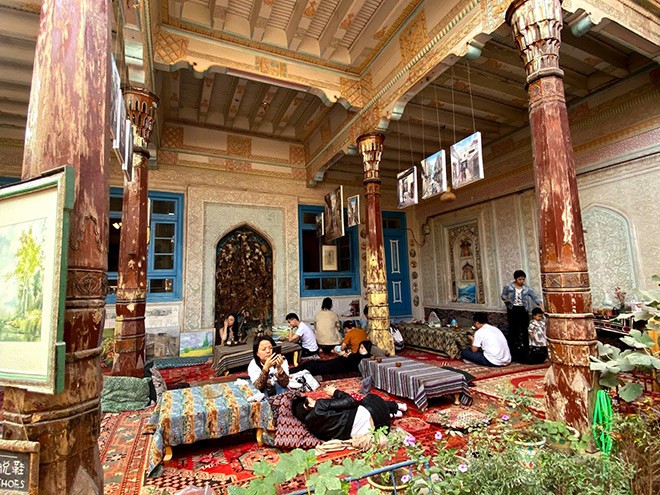 Visitors rest and relax in what was once a prayer room of a mosque in Kashgar in the western part of the Xinjiang Uighur Autonomous Region. (Atsushi Okudera)
Visitors rest and relax in what was once a prayer room of a mosque in Kashgar in the western part of the Xinjiang Uighur Autonomous Region. (Atsushi Okudera)
KASHGAR, China–At a domed building here in early October, the Islamic crescent symbol that indicated it had been a mosque had been removed.
The interior of the building had also been radically altered into a cafe.
What had once been a large prayer room had been turned into a rest area for tourists. Visitors who appeared to be Han drank tea or laid down to rest.
A source said the operator of the cafe was a Han from Guangdong province who began operations in May 2019 after rebuilding what had once been a house of worship.
One local resident was obviously upset that mosques in Kashgar were being turned into restaurants and rest areas.
“We are afraid to pray outside of our homes so we all gather at home to offer prayers,” the resident said.
UIGHUR MOSQUES TARGETED
Chinese authorities have moved to close a large number of mosques used by ethnic Uighurs in the Xinjiang Uighur Autonomous Region.
In both the region capital of Urumqi and Kashgar in the western part of the region, a number of mosques had been converted into cafes and other tourist destinations for Han Chinese.
And Beijing has not stopped at religious institutions. In what was described as a state project to turn the ancient city of Kashgar into a major tourist destination, parts of the city where homes and other buildings were constructed in the traditional Uighur style has been torn down and rebuilt over the past decade.
According to local residents, a large number of small and midsize mosques that were scattered around the old part of town have been closed over the past two to three years.
Another building about a minute’s walk from the former mosque also had part of its tower demolished and the former place of worship had also been turned into a cafe.
Another mosque in the eastern part of the residential district had been converted into a souvenir shop offering jade products.
Of the six mosques visited in the old city of Kashgar, five had been closed.
One Han operator of a cafe said the mosque was being rented from the local government. Mosques are apparently owned and managed by the local government and rented out for other purposes once they are closed.
A study by the Australian Strategic Policy Institute (ASPI) found a similar trend in other parts of the Xinjiang Uighur Autonomous Region.
In a report released in September, ASPI made a comparison using satellite images. A sample of 533 mosques out of the 24,000 or so in the region was selected. Since 2017, about 65 percent of the mosques had been either demolished or reconstructed for other purposes.
Violent clashes between Uighurs and Han in the past has led Beijing to strengthen its oversight of Islam. One method used is the Sinicization of the religion.
A researcher in a Communist Party organ in Xinjiang issued a report in 2015 that said, “The number of mosques in Xinjiang greatly exceeds the number needed for ordinary religious activities and some have become bases for separatists and radicals.”
Wang Wenbin, a Chinese Foreign Ministry spokesman, harshly criticized the ASPI report, calling it “an anti-China fabrication.”
SINICIZATION EFFORTS SEEN
A similar picture was also seen in Urumqi.
The metal gate to one mosque was closed and crescent symbols had been removed from the top of the columns that are an architectural feature of mosques. Peeking over the gate found construction materials and garbage strewn within the building.
A Uighur man who once prayed at the mosque said, “During the New Year, so many Muslims gathered there that some had to pray outside the building because not everyone could get in.”
According to a Communist Party official of the committee with jurisdiction over the district where the mosque is located, the building was designated in 2017 as dangerous because it did not have sufficient anti-quake measures. The official said the mosque was closed to protect the lives of residents.
Another mosque in the Shuimogou district had also been closed a few years ago because it was also classified as dangerous.
The ASPI study found that 35 percent of the mosques in Urumqi and 46 percent in Kashgar had been either demolished or reconstructed. The ratios were relatively low because domestic and foreign tourists often visit the two cities.
However, in rural areas in the north and south of the autonomous region about 80 percent of the mosques have been demolished.
A male ethnic Hui who said he was Muslim indicated that the mosque closures were meant to give Chinese authorities greater control.
“Closing the smaller mosques and forcing people to gather in larger mosques may make it easier to manage the people,” the man said.
There were other signs that Beijing was implementing Sinicization of the mosques.
One mosque in Urumqi prominently displayed not only the Chinese flag, but also displayed banners with the core values of the Chinese Communist Party.
Since the 2015 party decision to promote the Sinicization of religions, mosques have begun putting up banners calling for “ethnic solidarity” and pursuing “the Chinese dream.”
A visit to Hainan island in southern China in September led to a mosque that displayed not only a photo of Chinese President Xi Jinping, but also a sign urging visitors to read and study from his writings.
The intensified crackdown on Uighurs dates to around 2009 when about 2,000 people were killed or injured in violent clashes between Uighurs and Han Chinese in Urumqi. Subsequent violent acts in other parts of China were designated by authorities as terrorist acts plotted by those seeking Uighur independence.
Western nations have criticized the detention of Uighurs in what has been described as concentration camps as gross human rights violations.
https://www.asahi.com/ajw/articles/1382156
Desweiteren wird nun ein online-Anfragesystem gegen katholische, islamische und christliche Glaubensfunktionäre eingerichtet, das angeblich betrügerische Fakemönche und Schwindler enttarnen soll, wenngleich wohl die katholische Untergrundskirche oder andere christlichen und islamischen Geistlichen gemeint sein dürften, Buddhisten und Daoisten scheinen als Teil der chinesischen Kultur scheinbar ausgenommen, aber nicht tibetische Fakemönche, die sich als lebende Buddhas ausgeben- ist denn da das tibetische Pantschem Lamakind von Gnaden des Dalai Lama, das entführt wurde entflohen und geistert nun bettelnd als lebender Buddha herum? Zudem sich die Falungong ja auch als buddhistisch und daoistisch begreift, das aber als Konkurrenz zum nationalen Volksbuddhismus der Marke KP China verstanden wird und zwecks Erleuchtung in diesen Fragen gibt es ja schon das Büro 610.
“China opens inquiry system for information checking of Islamic, Catholic, Christian clergy
By Global Times Published: May 23, 2023 08:16 PM Updated: May 23, 2023 08:13 PM
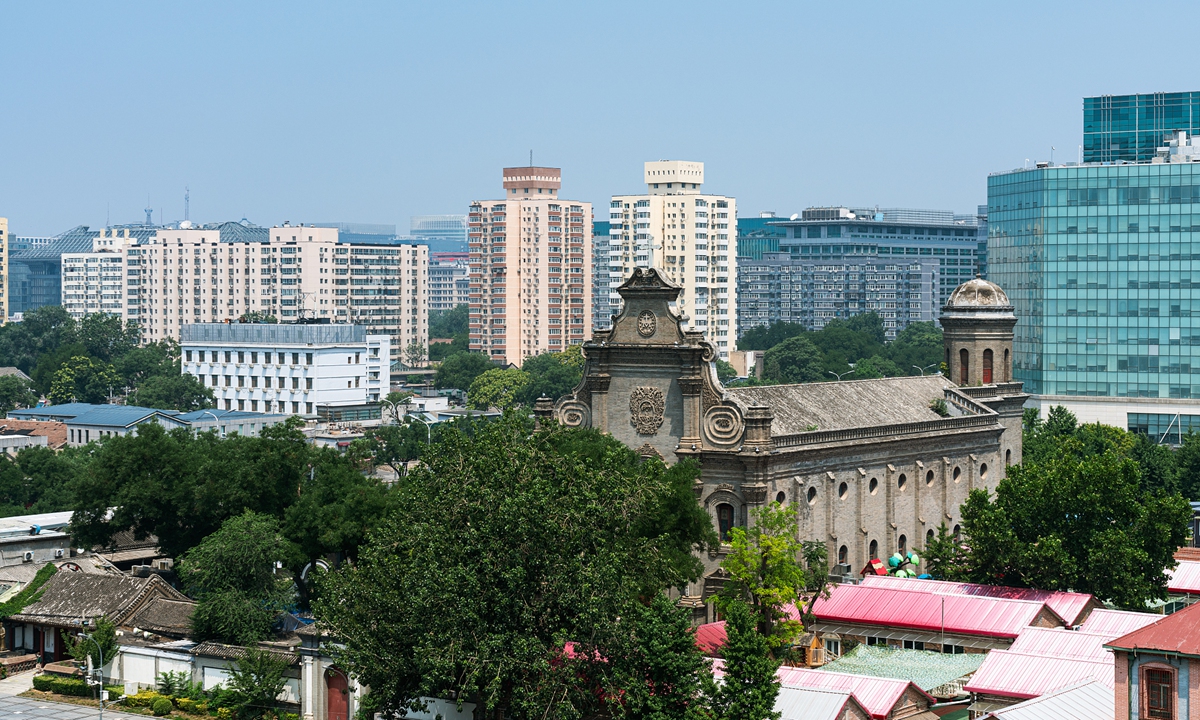
A photo of the outside of the Cathedral of the Immaculate Conception of the Archdiocese of Beijing taken on July 2, 2021. Photo: CFP
China has introduced the online inquiry system for the information checking of Islamic, Catholic and Christian clergy on Tuesday, a step to promote the openness of religious affairs as well as the identification and management of clergy.
Entering the websites of China Islamic Association, Catholic Church of China, China Christian Council and China’s State Bureau of Religious Affairs, the public can check the information of the clergy who have been identified and registered in accordance with the laws through the system after inputting two necessary message.
One is either the clergy’s name on the ID card or religious title. The other is either the clergy’s ID card number or the specific city where he or she is.
If the person was the clergy identified and registered in accordance with the laws, the information including the name, gender, photo, religious title, religious sect, clerical identity and clerical ID number will be presented. If not, the system will indicate that the person’s information was not found.
Similar information inquiry system for Buddhist and Taoist clergy has been launched in February to regulate the management on clerical personnel and fight against fraud cases related to fake religious personnel.
Fraud cases involving fake religious personnel have occurred from time to time over recent years, which has seriously tarnished the image of religious groups, disturbed social and public order, caused economic and property loss, and created an extremely bad social impact, Xinhua News Agency reported.
In 2021, Wang Xingfu in Jinan, East China’s Shandong Province, was sentenced to 25 years in prison after he illegally amassed nearly 200 million yuan ($29.11 million) and raped or molested several female disciples by faking an identity as a Living Buddha of Tibetan Buddhism.
Global Times
https://www.globaltimes.cn/page/202305/1291213.shtml
Desweiteren die Pandadiplomatie. Nachdem während der Ballonaffäre der Tod eines chinesischen Pandas in einem US- Zoo seitens der KP China als nationale Tragödie aufgeblasen und auch etliche Verschwörungstheorien in Sachen „wahrer Todesursache“ seitens erboster nationalistischer chinesischer netizens verbreitet wurden und in einer Art nationalem Heimholungsakt der verbliebene Panda aus dem US- Zoo wie quasi ein befreiter mißhandelter politischer Gefangener wieder nach China überführt wurde, wie auch ein Pandabär aus Japan heim ins Reich der Mitte geholt wurde, wird der Tod eines 21jährigen Pandas im Zoo von Thailand nicht zum Anlass genommen, die Pandadiplomatie gegenüber Thailand infrage zu stellen oder gar zu beenden. Scholz und Baerbock sollten da ein aufmerksames Auge auf die beiden chinesischen Pandas im Berliner Zoo haben, die Xi und Merkel so medienträchtig besuchten.
“21-year-old giant panda died of multiple organ failure in Thailand: experts
By Global Times Published: May 23, 2023 10:18 PM
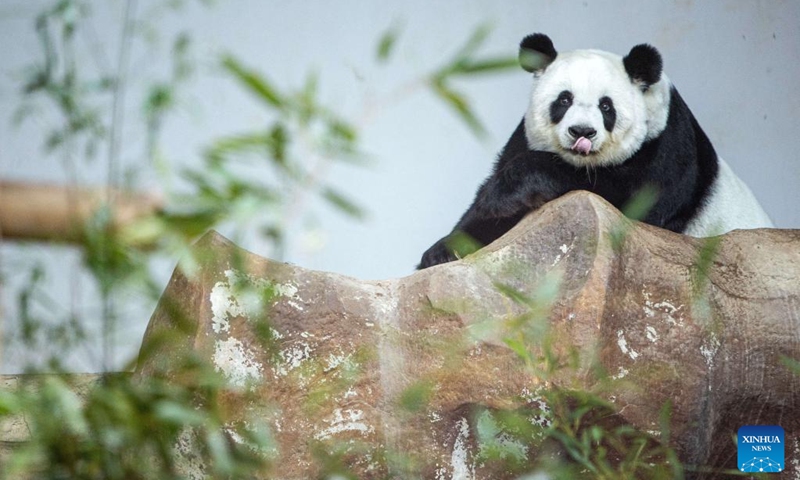
Giant panda Lin Hui rests at Chiang Mai Zoo in Chiang Mai, Thailand, Dec. 23, 2022. Lin Hui arrived in Chiang Mai on loan from China at the age of two in 2003. (Xinhua/Wang Teng)
Giant panda Lin Hui, the 21-year-old star attraction at Chiang Mai Zoo in Thailand, has died of multiple organ failure caused by atherosclerosis and embolism. The diagnosis was made after pathologic and etiological examination by a joint team of experts from China and Thailand, the China Conservation and Research Center for the Giant Panda said in a statement on Tuesday.
Lin Hui passed away on the morning of April 19 after fainting suddenly the day before. The zoo announced that Lin Hui first showed unusual symptoms on April 18 and was given a close examination, the Bangkok Post reported.
In a video taken by a tourist who visited the zoo on Tuesday, Lin Hui was seen lying feebly on the ground with blood stains on her nose and neck. She also seemed a bit nauseous, the tourist said in the video.
Upon learning the news, experts at the China Conservation and Research Center for the Giant Panda immediately reached the zoo to guide medical rescue efforts for the panda, but regrettably they were unable to save her life, Chinese Foreign Ministry spokesperson Wang Wenbin said at a press briefing.
The Chinese side attached great importance to the death of Lin Hui and urgently deployed experts to Thailand to investigate the cause of death, read the statement on the website of the China Conservation and Research Center for the Giant Panda.
Experts concluded that the elderly panda had died of multiple organ failure due to atherosclerosis and embolism. The nosebleed seen in the video was caused by hemangioma in her nasal cavity and contamination in other parts of her fur.
Chinese experts also conducted a thorough and detailed assessment of the facilities, medical team, food management, health system and diet management of the Chiang Mai Zoo where Lin Hui lived, and confirmed that it meets the requirements for giant panda breeding management and disease prevention and control.
Lin Hui was born in China on September 28, 2001. She was sent to Chiang Mai Zoo on October 12, 2003 as a goodwill ambassador between the two countries. She was scheduled to return to China this year.
Under the loving care of Chinese and Thai professionals, she has brought much joy to the Thai public over the years and has played an active role in promoting China-Thai cooperation in giant panda conservation and civil exchanges, Wang noted.
The Bangkok Post said Lin Hui was an instant star attraction. More than 7.4 million visitors have visited the zoo since October 2003 to see Lin Hui and Chuang Chuang, the two giant pandas on loan from China, according to the zoo director.
Since the launch of the China-Thailand Giant Panda research project 20 years ago, the two sides have achieved positive results in the protection and breeding of endangered species, as well as disease prevention and control, public education and other aspects, making positive contributions to the friendship between the two countries.
Both China and Thailand deeply regret the loss of Lin Hui, and the two countries will work together to deal with the aftermath of it, the China Conservation and Research Center for the Giant Panda noted.
Global Times
https://www.globaltimes.cn/page/202305/1291234.shtml
Ganz unbeantwortet bleibt Chinas Kulturkampf in rahmen der Global Civilizational Initiative nicht: Die antikommunistische buddhistische Massensekte Falungong, die auch Klimaschutz , Feminismus, Wokeness und Liberalismus als Neokommunismus sieht, unter ihrem Führer Li Hongzhi wiederum führt ihre eigene Global Civilizational Initiative mittel ihrer Kulturpropgandashow Shen Yun, die momentan auch auf Europatour ist. Diesmal. auch in Prag. In Sachen Antikommunismus versteht man sich ganz gut und Shen Yun ist nicht nur ein farbenträchtiges Kulturfestival, sondern eine eigene Geschichtsschreibung- und interpretation der Falungong, wie chinesische Kultur ohne Unterdrückung der KP China angeblich authentisch und wirklich aussieht und zu sein hat, zudem sie auch ihre eigene Verfolgung durch die KP China in ihre Kulturpropagandastücke einbaut. Jedenfalls hat man da auch mal einen CEO und auch einen Bürgermeister von der Piratenpartei als Fans gewonnen, was ausgiebig als quasi welthistorischer Erfolg herausposaunt wird:

Am Nachmittag des 12. März 2023 gab Shen Yun Global Arts seine letzte Vorstellung des Jahres im Prager Kongresszentrum in der Tschechischen Republik, die Karten waren im Voraus ausverkauft
Vier ausverkaufte Aufführungen
Familienunternehmer aus Prag: „Die Shen-Yun-Tänzer sind voller Energie“
Epoch Times17. März 2023
Die vier Shen-Yun-Aufführungen in Prag waren ein voller Erfolg. Alle Shows waren ausverkauft und das Publikum begeistert. Damit beendet die Shen Yun Global Company ihre Europatournee. Die Shen Yun International Company wird ihre Europatournee am 24. März in Basel starten.
Am Nachmittag des 12. März 2023 führte die chinesische Künstlergruppe aus New York, Shen Yun, ihre vierte und letzte Aufführung im Prager Kongresszentrum auf. Zahlreiche Prominente waren unter den Besuchern. Das Publikum freute sich nicht nur über die wunderschöne Aufführung, sondern auch über die Rückbesinnung auf traditionelle Werte.
CEO einer Unternehmensgruppe: „Die Shen-Yun-Tänzer sind voller Energie“
Unter dem Publikum befanden sich auch Dr. Oldřich Gojiš und seine Frau Eva Gojšová. Oldřich Gojiš ist einer der beiden Gründer der tschechischen Unternehmensgruppe für Molkereiprodukte Interlacto und der derzeitige CEO. Auf der Forbes-Rangliste der tschechischen Familienunternehmen liegt die Gruppe auf Platz 27.

Oldřich Gojiš, Gründer und Präsident der Unternehmensgruppe Interlacto mit seiner Frau Eva Gojšová.
Gojiš sagte, er sei zwar schon in China und an vielen anderen Orten auf der Welt gewesen, aber Shen Yun zu sehen, sei eine ganz besondere Erfahrung gewesen. „Ich mag Shen Yun“, sagte er. „Ich liebe die Show, sie ist wunderbar und sehr interessant. Vor allem gefällt mir ihr Thema. Jede (Show) hat ein anderes Hintergrundbild, das interessant ist und die chinesische Mentalität widerspiegelt. Ich fühle mich nach der Vorstellung sehr wohl.“
Der Unternehmer war beeindruckt von den außerordentlichen Leistungen der Shen-Yun-Darsteller und dem hohen Koordinationsniveau des gesamten Teams: „Mein Lieblingsprogrammstück war das, in dem die [tibetischen Männer] in den verschneiten Bergen tanzten. Es war lebendig und voller Energie. Ich fand, sie haben sehr gut zusammengearbeitet und waren sehr gut. Ich glaube, es waren 20 oder 25 von ihnen. Das ganze Team war gut zusammengestellt. Es war brillant.“
Gojiš lobte Shen Yun für die gute Inszenierung und die leichte Verständlichkeit: „Shen Yun hat einen großartigen Job gemacht und die einzelnen Stücke auf eine leicht verständliche Weise vorgetragen.“
Auch seine Frau Eva Gojšová zeigte sich begeistert von Shen Yun: „Ja, es hat mir sehr gut gefallen. Die Aufführung hat mich interessiert, weil sie mich dazu gebracht hat, über eine Menge Fragen nachzudenken, auf die ich Antworten gesucht habe. Ich glaube, dass Shen Yun den Zuschauern viel, viel mehr bringt, weil es eine Geschichte ist, die den Glauben thematisiert, genauso wie es sein sollte.“
„Ich denke, dass Shen Yun für die heutige Gesellschaft wichtig ist, besonders in der Gegenwart. Es bringt die Menschen dazu, die Geschichte und die Gegenwart zu verstehen und beides in Zusammenhang zu bringen. Das ist sehr wichtig.“
Herr Gojiš ergänzte: „[Shen Yun] ermöglicht, dass sich Menschen begegnen, und es hilft, andere Kulturen zu verstehen.“
Gelebte Tradition
Für Matěj Ševčík ist Familie und Tradition ein großes Anliegen, deshalb war es ihm umso wichtiger, gemeinsam mit seiner Familie Shen Yun zu sehen. Nachdem er letztes Jahr mit seiner Frau Lanka Novakova und seiner Tochter da war, brachte er diesmal seine Eltern und seinen Schwiegervater mit.

Matěj Ševčík und seine Frau Lanka Novakova im Prager Kongresszentrum
„Es hat mir sehr gut gefallen, die Farben waren farbenfroh, die Geschichten informativ und interessant und ich hatte viel Spaß beim Zuschauen“, sagte der leitende Unternehmensberater bei PricewaterhouseCoopers Tschechien nach der Vorstellung.
„Ich habe Shen Yun schon einmal im letzten Jahr gesehen und deshalb sind wir heute noch mal gekommen. Meine Tochter lernt gerade tanzen, also musste sie es noch einmal sehen“. Seine 10-jährige Tochter Linda, die neben ihrem Vater stand, konnte es kaum abwarten zu sagen, wie sehr ihr Shen Yun gefallen hat.
Ševčík findet Shen Yuns Mission, das göttliche Erbe der 5.000-jährigen chinesischen Kultur wiederzubeleben, das von der Kommunistischen Partei Chinas (KPC) zerstört wurde, sehr „stark“. „Es ist eine sehr starke Botschaft. Ich liebe sie. Früher hatten wir hier auch Probleme mit dem Kommunismus.“
Für Ševčík gehören zur Tradition auch Dinge wie Liebe und Verantwortung für die Familie. „Das ist eine starke und kraftvolle Assoziation für mich und ich verstehe sie sehr gut. Ich komme vom Land, wo Traditionen noch gut gepflegt werden und die Familie wichtig ist. Das ist der Teil der Show, der mein Herz wirklich berührt, er ist wirklich gut.“
„Letztes Jahr sind wir als Paar mit unserer Tochter gekommen. Dieses Jahr haben wir die ganze Familie mitgebracht, einschließlich meiner Eltern und meines Schwiegervaters. Nur mein Sohn war zu jung, um zu kommen, und meine Schwiegermutter konnte nicht kommen, weil sie auf ihn aufpasste.“
Ševčíks Frau Lanka Novakova, eine Sportlehrerin, sagte: „Mein Lieblingstanz am Ende war ‚Gesang der verschneiten Berge‘, das war wirklich, wirklich gut.“ Beim tibetischen Tanz fühlte sie sich „energetisiert“. Sie lobte die Synchronität. „Die Tänzerinnen und Tänzer tanzten eine Einheit. Sie machten die gleichen Bewegungen zum gleichen Zeitpunkt, das war wirklich wunderbar.“
Fast zu Tränen gerührt
Michal Černý ist Partner und Direktor für Einkauf und Verkauf bei Keenspire Investments, das sich unter anderem auf die Entwicklung von Immobilien und Investitionen konzentriert. „Ich liebe Shen Yun, es ist eine hervorragende Show“, sagte er gegenüber Epoch Times. Er hält es für wichtig, dass Shen Yun die traditionelle Kultur wiederbelebt.

Michal Černý bei Shen Yun in Prag.
„Das Design der Show, die Kostüme sind sehr ansprechend, wie machen sie das?“, fragte er. „Auch die Hintergrundanimationen waren sehr professionell und hatten gleichzeitig eine starke kulturelle Note.“
Der bewegendste Teil der Show war für Černý der Tanz „Wasserärmel“. „Die Damen tanzten mit langen Ärmeln und [diese Szene zu sehen], trieb mir Tränen in die Augen.“ Als er die langen Ärmel auf der Bühne flattern sah, „war ich so gerührt, es hat mein Herz berührt“.
Shen Yun präsentiert dem Publikum die Essenz und die Werte von 5.000 Jahren traditioneller chinesischer Kultur. Černý ist der Meinung, dass diese Botschaften wichtig sind: „Ich denke, die Botschaften, die man von der Show spüren kann, sind erstens auf kultureller Natur und zweitens auf sozialer. Das ist absolut wichtig.“
Černý bewundert die energiegeladenen Tanzdarbietungen der Shen-Yun-Künstler. „Ich fühle hier definitiv eine kulturelle Verbindung. Ich habe mich oft gefragt, was für eine Hingabe und harte Arbeit hinter der Aufführung steckt. Es ist unglaublich!“
Černý empfiehlt Shen Yun gerne an Freunde und Familie weiter: „Es ist zweifellos eine faszinierende Erfahrung und ich würde ihnen auf jeden Fall empfehlen, die Show zu besuchen, es ist großartig, [Shen Yun] zu sehen.“
Vize-Bürgermeister von Tiefgründigkeit beeindruckt
Der Vize-Bürgermeister von Chrudim, Pavel Štěpánek, und seine Frau Nikola genossen die Vorführung nach eigenen Angaben sehr. Sie waren von der Tiefgründigkeit der Inhalte sehr beeindruckt.
Pavel Štěpánek ist Mitglied der Piratenpartei Tschechiens und fungiert als nationaler Wahlkoordinator der Partei. Auch ist er langjähriger Vorsitzender und stellvertretender Bürgermeister der Stadt Chrudim. Die Stadt befindet sich im Osten von Prag, rund hundert Kilometer von der Hauptstadt entfernt. Štěpánek ist für die Behörde für Verkehr, Soziales und Bauwesen zuständig.
„Shen Yun hat für mich eine sehr tiefe Bedeutung. Ob nun die Musik oder der Tanz, ich war beeindruckt von der Geschichte des Tanzes und der Tiefe der Aufführung.“ Zu dem Stück über die Verfolgung von Falun-Gong-Praktizierenden in China, das den illegalen Organraub zeigt, sagte er: „Dieses Tanzdrama, das die Übel zeigt, hat mich am meisten berührt, es hat mich gefesselt.“
Der Politiker bedauert, dass Shen Yun nicht in China auftreten kann. „Was Shen Yun uns hier zeigt, ist eine traditionelle chinesische Kunstform. Shen Yun kann zwar um die Welt touren, aber nicht in ihrem eigenen Land auftreten.“
Seine Frau Nikola sagte, der Besuch sei ein Geburtstagsgeschenk für ihren Mann: „Ich war von der Aufführung verzaubert und angenehm überrascht von der Tiefe der Show. Es war faszinierend zu sehen, wie die Aufführung dem Publikum Werte vermittelte, indem sie Geschichten aus der traditionellen Geschichte auf die heutige Welt übertrug. Es war ein wunderbares Geburtstagsgeschenk.“

Pavel Štěpánek, stellvertretender Bürgermeister von Chrudim, und seine Frau Nikola.
Nikola bedauerte ebenfalls, dass Shen Yun nicht auf dem Festland auftreten kann: „Was mich überrascht hat und neu für mich war, ist, dass die Shen-Yun-Künstler eigentlich aus New York kommen und dort [auf dem chinesischen Festland] nicht auftreten können. Aber was mich glücklich macht, ist, dass sie durch die Welt touren und den Menschen durch diese Kunstform eine wichtige Botschaft vermitteln.“
Dieser Artikel erschien im Original auf epochtimes.com unter dem Titel:神韵布拉格四场全爆满 主流盼传统回归 (deutsche Bearbeitung nh)
Derweil nun auch der erste asiatisch-jüdische Comicheld, dessen Ursprünge auf die Unterdrückung der jüdischen Gemeinde im chinesischen Kaifeng zurückgehen. Leider hat die Global Time dies nicht kommentiert. Juden sind ja in China fast nicht existent, eine Minderheit unter den Minderheiten und solange die Unterdrückung der chinesischen Juden in Kaifeng und China nicht mit den Uiguren, dem Holocaust oder als Religionsunterdrückung der KP China in Verbindung gebracht wird, bleibt dies sowohl unter der Wahrnehmungs- als auch Interventionsschwelle. Zudem möglicherweise die damalige Unterdrückung auch feudalistischen Warlords und dem alten China in die Schuhe geschoben werden kann oder der Kulturrevolution.
“Asian-Jewish superhero fights 1970s Chinese mob in new comic book
First character of her kind in the medium battles to save parents, members of China’s Kaifeng Jewish community
By Julian Voloj 20 May 2023, 4:18 am

Leah Ai Tian is the hero of ‚The Last Jewish Daughter of Kaifeng.‘ (FairSquare Comics via JTA)
JTA — An independent comic book publisher that aims to promote diversity in comics is about to spotlight a historic new character: the Asian-Jewish Leah Ai Tian, also known as “The Last Jewish Daughter of Kaifeng.”
The character is the brainchild of Fabrice Sapolsky, co-founder of the Queens, New York-based FairSquare Comics, which works to “promote and give more exposure to immigrants, minorities and under-represented creators of the word.”
“The Last Jewish Daughter of Kaifeng,” which debuts June 7, is the latest installation of the Intertwined series of comics, which Sapolsky and fellow Frenchman Fred Pham Chuong started in 2017.
Israeli Caracal Brigade soldiers (IDF)- volunteer at Safra Children’s Hospital, Sheba
Leah, who made a brief appearance in the first Intertwined book, has the ability to manipulate anything water-based and travel through streams — not unlike a certain character in the popular TV show “Avatar: The Last Airbender.”
The book tells her complex origin story, which Sapolsky said is meant to “explain the reality of being a minority in a country that does not accept you as a minority.”
At first, Leah lives freely as a Jew in 1970s New York City — she wears a chai necklace, has opened a kosher Chinese restaurant and says her rabbi calls her powers “a blessing” from god. But the reader learns that she had left China to avoid a forced marriage to a mob lord who now terrorizes Kaifeng — a large city in eastern China home to the remnants of the country’s only native Jewish community.
That community, once thought to be at least a few thousand strong, by the time of Leah’s story was thought to be mostly dispersed or assimilated into the non-religious society of the Cultural Revolution. Leah returns home to try to save her parents and bring them to New York, where they could practice their religion freely.
Sapolsky’s interest in the Jewish community in Kaifeng dates back to the 1990s, when he was a teenager and his Jewish camp in France one year held “Kaifeng-themed” activities, meant to educate campers about Chinese Jews.
Born in France to a Sephardic mother from Algeria and an Ashkenazi father with roots in today’s Ukraine, his own background informed his interest in Jewish diversity.
“When working on the original concept of Intertwined, I knew we had to have a Jewish character, and there had never been an Asian Jewish character in comics,” Sapolsky said.
For Sapolsky, it was important to make Leah’s story “real, make it authentic, make it believable.” He talked to consultants about Kaifeng history and culture, making sure even the architecture depicted on the page was realistic.
“The two artists, Fei Chen and Ho Seng Hui, are from China and Malaysia, and never thought about Jews before this project, so they learned while drawing the book,” he said. “Will Torres, a Christian of Puerto Rican descent, helped with the inking, and the coloring was done by Argentine Exequiel Roel.”
The goal of the story was not only to refer to the minority experience in China — but also to the realities in the United States, Sapolsky’s adopted home.
“Unlike in France, where Jews are clearly defined as a minority, in this country they are widely perceived as simply white, which denies the diversity of Judaism,” he said.
https://www.timesofisrael.com/asian-jewish-superhero-fights-1970s-chinese-mob-in-new-comic-book/